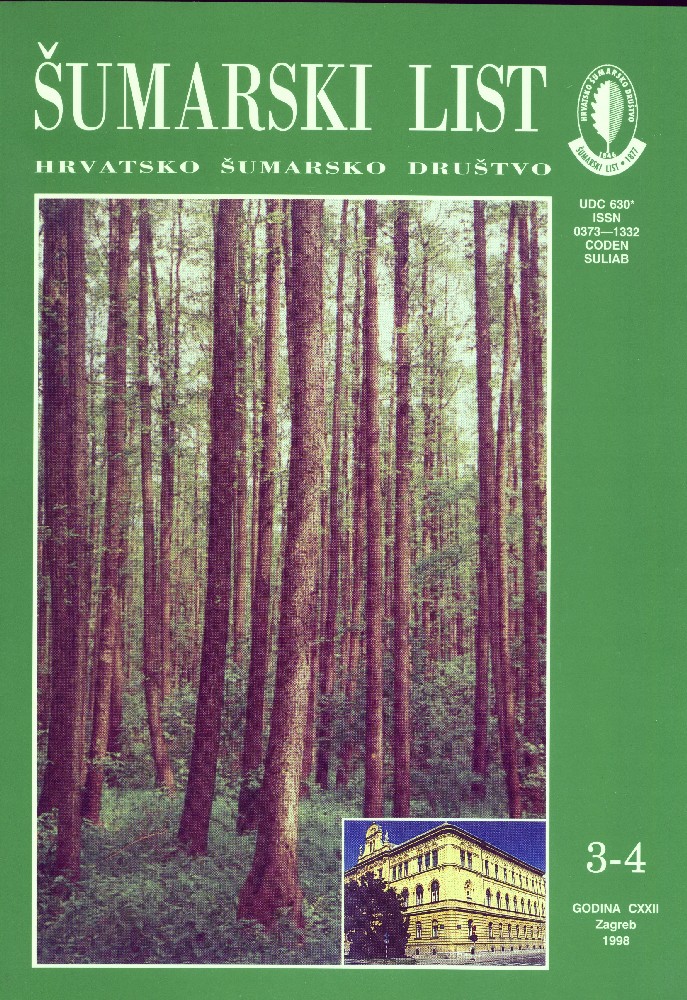
broj: 3-4/1998
pdf (16,6 MB) |
|
||||||||||||||
| IZVORNI ZNANSTVENI ČLANCI | ||
| Kajba D., Krstinić A. | UDK 630* 238 (Alnus L.) 001. | |
| Species of the Genus Alnus L. Suitable for Biomass Production pdf HR EN | 131 | |
| Kajba D., Krstinić A., Komlenović N. | UDK 630* 238 (Salix sp.) 001. | |
| Arborescent Willow Biomass Production in Short Rotations pdf HR EN | 139 | |
| Trinajstić, I. | UDK 630* 188 (Pinus nigra Arnold) 001. | |
| Nomenclature and Syntaxonomic Revision of Submediterranean Forests of Austrian Pine (Pinus nigra Arnold) in Croatia pdf HR EN | 147 | |
| Summary: In the work the nomenclatural and syntaxonomic revision of the Submediterranean forests of the Austrian pine (Pinus nigra Arnold) described by Anić (1957) under the name of "Pinetum nigrae submediterraneum" was made. In compliance with the available syntaxonomic code, the said forests association is described under the name of as. Ostryo-Pinetum nigrae Trinajstić, ass. nov., and classified in the alliance Ostryo-Carpinion orientais, the order Quercetalia pubescentis and the class Querco-Fagetea.As characteristic species of the association, only the Pinus nigra has been indicated, and this is so far the only forest association of conifers within the aliance Ostryo-Carpinion orientalis and the order Quercetalia pubescentis. As the differential species of the association, the 16 of them, those species which are generally considered as the elements of the calciphilous forests of the order Erico-Pinetalia in its widest sense have been indicated. Among them, in the shrub layer predominant is Amelanchier ovalis and in the floor layer Buphtalmum salicifolium, Dorycnium germanicum and Carex humilis. It is important to emphasize that the presence of the so-called "dolomitophytes" the elements of the order Erico-Pinetalia, such as Helleborus niger, Polygala chamaebuxus and Erica herbacea, may be neglected. This is the most evident proof that the Austrian pine forests on the northern Velebit do not belong to the order Erico-Pinetalia. Characteristic species of the alliance Ostryo-Carpinion orientalis there are 12 species. Characteristic species of the order Quercetalia pubescentis, there are indicated 23 species. They are particularly numerous in the shrub layer. Characteristic species of the class Querco-Fagetea are relatively poorly. Accompanying plants cover more than 50% of the floral composition. Among them, the group of grassland vegetation elements of the order Scorzonero-Chrysopogonetalia predominantes with 30 species in the table and 1 species outside the table. This shows that, at the time when their floral composition was studied more than 40 years ago, the pine forests stands also served as pasture-grounds. Other accompanying plants are elements of very different associations rangign from the wheed and ruderal to the forest ones. | ||
| PRETHODNO PRIOPĆENJE | ||
| Gallo, C. | UDK 630* 585 + 48 (Fagus silvatica L.) | |
| Assessment of Beech (Fagus sylvatica L.) Damage Using Digital Interpretation of Colour Infrared Aerial Photography pdf HR EN | 155 | |


